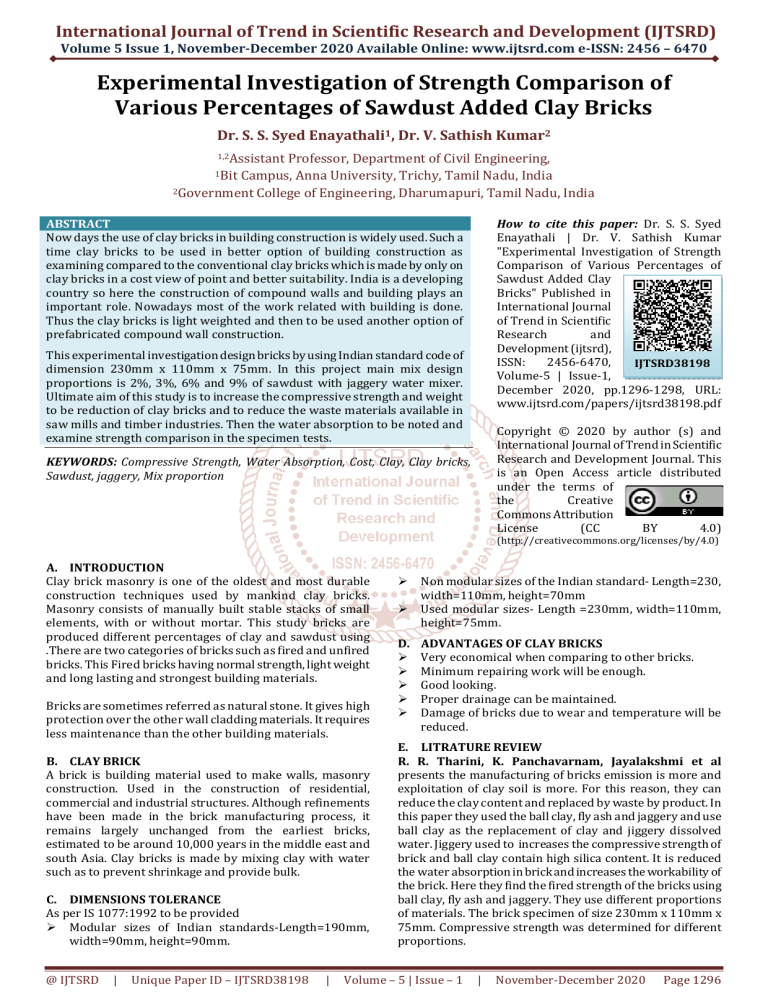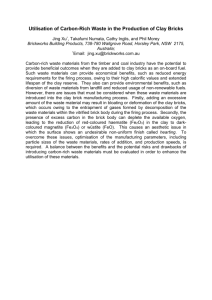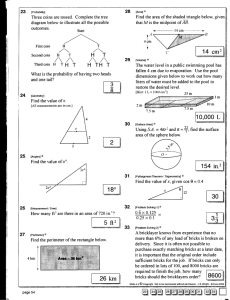
International Journal of Trend in Scientific Research and Development (IJTSRD)
Volume 5 Issue 1, November-December 2020 Available Online: www.ijtsrd.com e-ISSN: 2456 – 6470
Experimental Investigation of Strength Comparison of
Various Percentages of Sawdust Added Clay Bricks
Dr. S. S. Syed Enayathali1, Dr. V. Sathish Kumar2
1,2Assistant
Professor, Department of Civil Engineering,
Campus, Anna University, Trichy, Tamil Nadu, India
2Government College of Engineering, Dharumapuri, Tamil Nadu, India
1Bit
ABSTRACT
Now days the use of clay bricks in building construction is widely used. Such a
time clay bricks to be used in better option of building construction as
examining compared to the conventional clay bricks which is made by only on
clay bricks in a cost view of point and better suitability. India is a developing
country so here the construction of compound walls and building plays an
important role. Nowadays most of the work related with building is done.
Thus the clay bricks is light weighted and then to be used another option of
prefabricated compound wall construction.
How to cite this paper: Dr. S. S. Syed
Enayathali | Dr. V. Sathish Kumar
"Experimental Investigation of Strength
Comparison of Various Percentages of
Sawdust Added Clay
Bricks" Published in
International Journal
of Trend in Scientific
Research
and
Development (ijtsrd),
ISSN:
2456-6470,
IJTSRD38198
Volume-5 | Issue-1,
December 2020, pp.1296-1298, URL:
www.ijtsrd.com/papers/ijtsrd38198.pdf
This experimental investigation design bricks by using Indian standard code of
dimension 230mm x 110mm x 75mm. In this project main mix design
proportions is 2%, 3%, 6% and 9% of sawdust with jaggery water mixer.
Ultimate aim of this study is to increase the compressive strength and weight
to be reduction of clay bricks and to reduce the waste materials available in
saw mills and timber industries. Then the water absorption to be noted and
examine strength comparison in the specimen tests.
Copyright © 2020 by author (s) and
International Journal of Trend in Scientific
Research and Development Journal. This
is an Open Access article distributed
under the terms of
the
Creative
Commons Attribution
License
(CC
BY
4.0)
KEYWORDS: Compressive Strength, Water Absorption, Cost, Clay, Clay bricks,
Sawdust, jaggery, Mix proportion
(http://creativecommons.org/licenses/by/4.0)
A. INTRODUCTION
Clay brick masonry is one of the oldest and most durable
construction techniques used by mankind clay bricks.
Masonry consists of manually built stable stacks of small
elements, with or without mortar. This study bricks are
produced different percentages of clay and sawdust using
.There are two categories of bricks such as fired and unfired
bricks. This Fired bricks having normal strength, light weight
and long lasting and strongest building materials.
Bricks are sometimes referred as natural stone. It gives high
protection over the other wall cladding materials. It requires
less maintenance than the other building materials.
B. CLAY BRICK
A brick is building material used to make walls, masonry
construction. Used in the construction of residential,
commercial and industrial structures. Although refinements
have been made in the brick manufacturing process, it
remains largely unchanged from the earliest bricks,
estimated to be around 10,000 years in the middle east and
south Asia. Clay bricks is made by mixing clay with water
such as to prevent shrinkage and provide bulk.
C. DIMENSIONS TOLERANCE
As per IS 1077:1992 to be provided
Modular sizes of Indian standards-Length=190mm,
width=90mm, height=90mm.
@ IJTSRD
|
Unique Paper ID – IJTSRD38198
|
Non modular sizes of the Indian standard- Length=230,
width=110mm, height=70mm
Used modular sizes- Length =230mm, width=110mm,
height=75mm.
D. ADVANTAGES OF CLAY BRICKS
Very economical when comparing to other bricks.
Minimum repairing work will be enough.
Good looking.
Proper drainage can be maintained.
Damage of bricks due to wear and temperature will be
reduced.
E. LITRATURE REVIEW
R. R. Tharini, K. Panchavarnam, Jayalakshmi et al
presents the manufacturing of bricks emission is more and
exploitation of clay soil is more. For this reason, they can
reduce the clay content and replaced by waste by product. In
this paper they used the ball clay, fly ash and jaggery and use
ball clay as the replacement of clay and jiggery dissolved
water. Jiggery used to increases the compressive strength of
brick and ball clay contain high silica content. It is reduced
the water absorption in brick and increases the workability of
the brick. Here they find the fired strength of the bricks using
ball clay, fly ash and jaggery. They use different proportions
of materials. The brick specimen of size 230mm x 110mm x
75mm. Compressive strength was determined for different
proportions.
Volume – 5 | Issue – 1
|
November-December 2020
Page 1296
International Journal of Trend in Scientific Research and Development (IJTSRD) @ www.ijtsrd.com eISSN: 2456-6470
Ali Ahmed Mohammed et al explains about the art work of
manufacturing bricks in the past and the current trend in the
bricks industry with respect to the raw materials, ways of
manufacturing and the out- comings. Moreover, the
hazardous impacts of the conventional brick manufacturing
will be wholly covered as well as the attempts of the
previous researches in treating the problem properly.
Fernando, Devika Madushani, Praththana, Nanayakkara
et al., deals about the Clay bricks have been made since
ancient periods. The higher demand for this brick fails to
support the needs. This is because clay is the non-renewable
materials. Therefore, new artificial cement blocks have been
introduced to satisfy the fast demand in the world. However,
the clay bricks are the most eco-friendly and form green
environment.
F.
Fig.1 Mixing of Sawdust with Jaggery Mixer
SCOPE
By using light weight clay bricks replacement of the
prefabricated compound walls.
This project is economical, so future scope is effectively.
Used control heavy weight deformation. Because gravity
pulls on light as well as matter.
G. OBJECTIVES
Comparison of compressive strength between clay
bricks and sawdust added clay bricks.
Make less the soil exploitation and use unwanted
wooden poles using the materials in the manufacture of
bricks.
Analyze water absorption and compressive strength in
the various percentages of clay and sawdust with
jaggery by adding water.
To Choose the optimum materials properties and ratios
to produce brick from sawdust with jaggery by mixing
water.
Clay is performed by adding of 2%, 3%, 6% and 9% of
sawdust with 100ml, 200ml, 300ml and 400ml of
jaggery mixer water.
Examine comparison of strength and water absorption
in the various percentages of sawdust added clay bricks.
H. QUANTITY OF MATERIAL
Table 1 Quantity of material
Materials
Total weight in kg
Clay
16.60
Sawdust
0.700
Jaggery mixer water
1 liter
Table.2 Proportions of Raw Material
Clay (% Jaggery Sawdust
SI.
Total
Mixers
of
mixer
(% of
NO
percentage
weight)
(ml)
weight)
1
Mix 1
100
0
0
100
2
Mix 2
94
100
2
96
3
Mix 3
94
200
3
97
4
Mix 4
94
300
6
100
5
Mix 5
94
400
9
103
@ IJTSRD
|
Unique Paper ID – IJTSRD38198
|
Fig.2 Mixing of Clay Sawdust with Jaggery Mixer
I. COMPARISON OF WEIGHT OF CLAY BRICKS
Clay bricks has different weight depending on the quantity of
clay and sawdust used in clay mixer proportions, type of
material replaced and percentage of material replaced during
mixer preparation.
Weight of clay bricks are calculated using normal
conventional weighing machine used in laboratory in
decimal values.
Material added to the clay mixture will increase and
decrease the weight of sawdust in bricks.
Weight of clay brick which has 20% of replaced sawdust
is greater than the normal conventional clay brick.
Table.3 Weight of Specimens
1st
2nd
3rd
specimen specimen specimen
Normal bricks
3.2
3.15
3.23
Sawdust 2%
2.550
2.500
2.530
Sawdust 3%
2.394
2.300
2.370
Sawdust 6%
2.266
2.250
2.200
Sawdust 9%
2.125
2.200
2.134
From the above table conventional sawdust clay bricks
weight is slightly lesser than the normal clay bricks
which has sawdust waste materials and it also has no
larger weight than the bricks.
Saw dust reduces the weight of clay bricks depending on
its proportion and density of type of dust used in clay
bricks.
Following stock diagram shows the average increment and
decrement of weight of clay bricks with gradually replaced
sustainable materials
Volume – 5 | Issue – 1
|
November-December 2020
Page 1297
International Journal of Trend in Scientific Research and Development (IJTSRD) @ www.ijtsrd.com eISSN: 2456-6470
K. CONCLUSIONS
By results of clay bricks testing the weight of bricks is
differed depending on the sawdust material replaced.
Conventional clay bricks gets 3.2 kg of average weight
after hardened. But other bricks are light weighted.
By adding the sawdust 2% at that time clay bricks
weight is high when compared to other adding
percentages respectively, Adding the jaggery water
mixer to be increased soundness and hardness because
its composition chemicals.
Fig 3 Weight of Specimens
Compressive strength of clay bricks has to be increased
by adding of sawdust decreased and is high when 2% of
sawdust and 100 ml of jaggery water mixer.
From the above stock diagram weight of clay bricks which
has lesser than the weight of normal conventional bricks
Conventional bricks with standard material gives the
compressive strength of 3.5 to above N/mm².
J. COMPARISON OF COMPRESSIVE STRENGTH
Compressive strength of clay bricks is calculated using
ultimate compressive load occurring when specimen gets
failure and bearing area of specimen. Generally, load is
applied in KN. A compression testing machine, the
compression plate which shall have a ball seating or plywood
in the form of portion of a sphere the centre which coincides
with the centre of the plate, shall be used.
Surface area of the specimen (rectangle)= 2lw + 2lh + 2wh
= (2×230×110) + (2×230×75) + (2×110×75)
=101600 mm².
Following details are the compressive load on bricks in after
burning compressive strength test.
Table 4 Compressive Loads on Specimen
S.NO Mixers Compressive strength N/mm²
1
Mix 1
2.95
2
Mix 2
1.96
3
Mix 3
1.47
4
Mix 4
1.18
5
Mix 5
0.89
Water absorption test is calculated at various
percentages of sawdust adding clay bricks to be 6% and
9% is to very low strength.
Good future reception is great the weight is less and the
strength of it is going to happen and it will be an
example of such innovations. After doing various studies
of different compounds
REFERENCES
[1] K. C. P. Faria, R. F. Gurgel, J. N. F. Holanda. “Recycling
of sugarcane bagasse ash waste in the production of
clay bricks”, Environmental Management, Vol. 101.
Pp. 7-12, 2012.
[2]
Taner Kavas. “Use of boron waste as a fluxing agent in
production of red mud brick”, Building and
Environment, Vol. 41. Pp. 1779–1783, 2006.
[3]
J. A. Cusido, L. V. Cremades, M. Gonza´lez. “Gaseous
emissions from ceramics manufactured with urban
sewage sludge during firing processes”, Waste
Management, Vol. 23. Pp. 273–280, 2003.
[4]
S. P. Raut, R. V. Ralegaonkar, S. A. Mandavgane.
“Development of sustainable construction material
using industrial and agricultural solid waste: A review
of waste-create bricks”, Construction and Building
Material, Vol. 25. Pp. 4037-4043, 2011.
[5]
M. I. Carretero, M. Dondi, B. Fabbri, M. Raimondo.
“The influence of shaping and firing technology on
ceramic properties of calcareous and non-calcareous
illitic–chloritic clays”, Applied Clay Science, Vol. 20.
Pp. 301– 306, 2002.
[6]
VorradaLoryuenyong,
ThanapanPanyachai,
KanyaratKaewsimork, ChatnarongSiritai. “Effects of
recycled glass substitution on the physical and
mechanical properties of clay bricks”, Waste
Management, Vol. 29. Pp. 2717– 2721, 2009.
The above table shows the Compressive load applied on test
specimen in kilo Newton (kN) which will the primary factor
to calculate the compression strength of bricks.
Fig 4 Compressive strenght Testing
Fig 5 Compressive Loads on Specimen
@ IJTSRD
|
Unique Paper ID – IJTSRD38198
|
Volume – 5 | Issue – 1
|
November-December 2020
Page 1298



